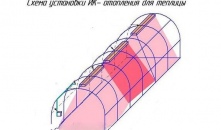Ceiling infrared heaters for a greenhouses

Infrared heaters for a greenhouse
For greenhouse holdings, it is very important to establish the proper heating. This is because the productivity and the resistance of the greenhouse to the weather and other factors mostly depend on the quality of the built heating system.
All known types of heating, which are used in usual premises, are suitable for the greenhouse. But there are some types that are the best for this special area.
Greenhouse heating: main types
So, in order to heat a greenhouse, you need to know at least approximately from what aggregates from the modern market you can select the appropriate form of heating. There are several types of systems:
- Heating with electrical installations (infrared heaters, fan heaters);
- gas heating;
- heat gun on diesel fuel;
- fan water heaters.
When choosing a particular model of the aggregate, you need to consider many specific features: the season, the variety of the vegetables you are going to grow, the area of the greenhouse etc.
Heating of a greenhouse with the use of the infrared rays: main features
Installations like this are based on the principle of excellent imitation of natural sunlight, ie, basically there is a "sun" in a greenhouse. The rays produced by the aggregate are "absorbed" by the surfaces and objects in the greenhouse, and, subsequently, give the heat to the surrounding air. So the effect is one hundred percent similar to the effect of the natural sunlight.
There are a number of advantages of the infrared systems:
- distribution of heat throughout the whole greenhouse room;
- practicality is at the highest level in comparison with the other types of heating;
- the economy of the infrared heaters;
- using this kind of heaters leads to the absolute absence of drafts
As it is known, in the systems of convective type, heated air is constantly striving in the upper layers of the room (in our case - a greenhouse). So cool air is accumulated in the lower layers. For the vegetation that is usually located on the floor, this kind of heating would be ineffective. But If you use infrared heaters for greenhouses, the uniformity of heat distribution is guaranteed.
Owing to the features of the radiator drafts do not come up at all. The equipment is often installed in places where the heat insulation is minimal (for example, near the window frames). The heat losses are compensated by the heater, which does not cause strong air flows.
The practicality of the heaters of infrared type is due to the ability to create some heating zones—a certain level of heating can be set for each zone. This way we can also see how economical this equipment is — there is no electricity consumption for heating the entire greenhouse. According to the experts, if the equipment is installed properly, you may save up to forty percent on the energy carriers.
The actual use of infrared emitters: key points
Today, infrared lamps for heating greenhouses are used throughout the different types of greenhouse space. Here are some features of the actual use that have been pointed out by experienced specialists:
- experienced gardeners note the growth of plant shoots while using long-wave infrared heaters: indexes increase in average from thirty to forty percent;
- a distinctive feature of these aggregates—no dry climate in the room;
- devices are absolutely noiseless, environmentally friendly—no allocation of harmful substances and gasses;
- one of the main advantages — heating of the soil from five to seven centimeters deep, which stimulates root growth of vegetation, no other heating system is able to achieve this result.
- with the help of infrared heating installations heating of the soil reaches 28 degrees Celsius—this temperature is the most suitable for a good growth of the plants, while the indoor temperature is maintained at 21 degrees.
Among the disadvantages of the infrared installations, many gardeners point out a high price. Indeed, compared to fan heaters or gas installations, the price of the is quite high. However, the percentage of energy savings (up to forty percent), as well as the growth of shoots of fruits and vegetables (up to thirty percent) will pay off this device in a couple of seasons.
Thus, heating of greenhouses using infrared systems is the most economical, environmentally friendly and the most practical option for heating greenhouse facilities.
